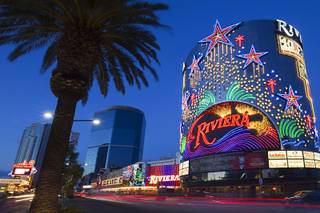Tourism executives offered more insight today into their plans to expand and renovate the Las Vegas Convention Center as they continued to make their case to a committee that will be influential in funding the project.
The Las Vegas Convention and Visitors Authority is already moving forward with its plans. To start the project, the authority bought the Riviera in February; it is now preparing to demolish the shuttered casino and clean up the site for use as outdoor exhibit space.
But the authority needs help from the Southern Nevada Tourism Infrastructure Committee to fund the next steps: building a new convention facility on the Riviera site, then revamping the existing convention center on Paradise Road.
The committee, which includes elected officials and casino executives, was convened by Gov. Brian Sandoval this year. It should submit a report next year that will include recommendations about funding for improvements to tourism-related facilities in the Las Vegas area.
At the committee’s meeting today, Terry Miller of Cordell Corp., which is helping the authority manage the convention center project, outlined the budget and construction plan.
His presentation indicated that the hard costs of constructing the new convention facility, which include the actual labor and construction materials, should be $365 per square foot. That’s not far off what San Diego had to pay in hard costs for a similar project, Miller noted.
Adding in other costs such as the general overhead for contractors, management fees, permitting, inspections and more, the cost of the construction phase is expected to increase to $600 per square foot. The new convention building will feature 1.4 million square feet of convention-related space, including a 600,000-square-foot exhibit hall, bringing the total budget for that part of the project to $860 million.
The next phase, when the authority will renovate the current convention center, will encompass 3.8 million square feet of work on existing public spaces, additional meeting rooms and more. It’s expected to cost $540 million, or $143 per square foot.
The total budget for both constructing the new facility and then renovating the existing convention center is $1.4 billion.
At first, the new convention building will not encompass the entire Riviera site. Part of the land closest to Las Vegas Boulevard will still be used for outdoor exhibit space even while the facility is constructed and after it opens, according to today’s presentation.
It’s all expected to take many years to complete — the authority doesn’t expect to wrap up the renovation part until 2022. An additional phase — which the presentation said would be “based upon market conditions” — could stretch the project even longer than that.
Once finished, the authority says its expansion and renovation will allow it to meet demand for more space and remain competitive with other cities.
The committee has not yet taken any action on the convention center plans, which have previously received pushback from Las Vegas Sands Corp.
Earlier in today’s meeting, the committee focused on pedestrian movement within the resort corridor.
The first takeaway: While the Strip has taken big steps toward becoming a more pedestrian-friendly environment in recent years, it can do more. Officials told the committee that the Strip has already made improvements such as widening the sidewalk in certain areas but that congestion and other issues in the area remain.
Clark County manager Don Burnette said the Strip has made moves to reduce the amount of densely trafficked space but that an increase in the number of street performers, for example, poses a challenge.
Another issue is the need for more law enforcement resources. Sheriff Joe Lombardo’s presentation showed that Metro Police has assigned less than one officer per 1,000 tourists on the Strip. The department saw a 6.6 percent increase in calls for service there last year, representing 22 percent of its total calls, according to Lombardo. He also said he was concerned by the fact that the department has recovered or impounded 76 guns on the Strip this year.
The city of Las Vegas also highlighted to the committee the steps it is taking to ease the pedestrian experience downtown, such as improvements to streetscapes, lighting, signage and taxi stands. Las Vegas has invested $47 million in the past seven years on pedestrian and streetscape improvements and plans on an additional $177 million over the next five years, according to the city’s presentation.
Additionally, City Manager Betsy Fretwell spoke of the benefits from the new performance zones recently put in place on the Fremont Street Experience. Between 3 p.m. and 1 a.m., street performers, also known as buskers, are required to remain within one of 38 zones assigned via a daily lottery. Fretwell said the zones have had an “immediate impact” by breaking up clusters of performers and creating a more organized environment for pedestrians.


